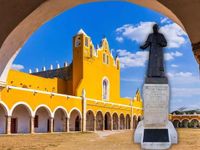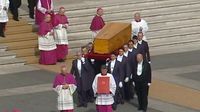On April 8, 2005, the world bid farewell to Pope John Paul II, a pontiff whose influence spanned over 27 years and left an indelible mark on global society. His death marked the end of a remarkable era in the Catholic Church, during which he became a beacon of hope and a powerful voice for peace, human rights, and interfaith dialogue.
As the sun rose that day, the Vatican prepared for a funeral that would draw an unprecedented number of heads of state and dignitaries from around the globe. It was a testament to his universal appeal, transcending political and ideological boundaries. The public farewell began at 10:00 AM, with his coffin leaving St. Peter's Basilica, carried by the papal attendants in a solemn procession.
Prior to this public display, a series of private rites had taken place over the preceding six days. These included the confirmation of his death by a physician from the Holy See and the breaking of his papal seal, a ceremonial act that marked the official end of his papacy. Joseph Ratzinger, who had served as one of his closest collaborators for 23 years, officiated the public mass. His heartfelt eulogy paid tribute to John Paul II’s life and legacy, highlighting the profound impact he had on millions.
Following the mass, representatives from various religions and cultures paid their respects, lining up to honor the pontiff. The funeral service was steeped in tradition, reflecting the solemnity of the occasion. After the final rites, John Paul II was laid to rest in the Vatican grottoes, beneath a simple marble slab, fulfilling his wish for a humble burial.
Fast forward to August 11, 1993, a date that remains etched in the hearts of many in Yucatán, Mexico. Pope John Paul II made a historic visit to the region, which was marked by emotional and significant events over two days. His arrival at the International Airport of Mérida was met with a grand reception, including a 21-gun salute, and he was welcomed by President Carlos Salinas de Gortari and Governor Dulce María Sauri Riancho.
One of the highlights of this visit was his mass at the atrium of the Convent of San Antonio de Padua in Izamal, attended by approximately 6,000 people. This event was particularly meaningful as he addressed representatives from various indigenous ethnic groups across the Americas, including Mayans, Aztecs, and Quechuas. During this significant moment, he expressed remorse for the historical injustices inflicted by colonizers and recognized the dignity and cultural richness of indigenous peoples. “In your cultures are the seeds of the word of God,” he stated, emphasizing the importance of these communities in the fabric of the Church.
The next day, on August 12, John Paul II officiated another mass in Mérida that drew an astounding crowd of over 800,000 faithful to the Eucharistic Field of Xoclán. His homily resonated deeply with the congregation as he urged the Yucatecos to be “salt of the earth and light of the world.” He called upon them to spread the message of Jesus, imploring them to be “sowers of the word.”
That evening, the Pope stayed at the Seminary of San Ildefonso, where he engaged with future priests, sharing insights and wisdom that would inspire the next generation of clergy. As he departed for Denver the following day, he left behind a powerful message: “May God bless Mexico!” echoing his commitment to the nation and its people.
The visit to Yucatán was not merely a pastoral mission; it was a pivotal moment that elevated the dignity of indigenous peoples and strengthened the Catholic faith in the region. The Pope’s acknowledgment of the rich cultural heritage of these communities fostered a sense of pride and recognition that had long been overlooked.
In the years since, the impact of his visit has been felt throughout Yucatán. The site of the mass in Mérida was later designated as Parque Juan Pablo II, a symbol of his legacy and a reminder of the profound connection he established with the local population. The emotional testimonies from that time reflect a deep appreciation for his efforts to bridge gaps between cultures and faiths.
Journalistic accounts from the period highlighted how John Paul II's presence in Yucatán was considered “providential,” especially as his visit was initially scheduled for 1992 but was postponed due to a surgical procedure. This delay allowed for an even greater anticipation and significance surrounding his eventual arrival.
In retrospect, Pope John Paul II’s pontificate was marked by a commitment to dialogue, reconciliation, and social justice. His visits to places like Yucatán served as a powerful reminder of the Church’s role in advocating for marginalized communities and fostering unity among diverse groups. As the world reflects on his legacy, it is clear that his influence continues to resonate, inspiring new generations to pursue peace and understanding.
As we remember the life of Pope John Paul II, it is essential to honor the lessons he imparted during his time on Earth. His dedication to the Church and its followers, combined with his efforts to uplift the voices of the oppressed, has left an enduring legacy that transcends borders and ideologies.





